EyeVision Software can be used in a variety of applications in packaging machines. One example is packaging inspection for sanitary napkins, panty liner and incontinence products.
The products are ejected from the production machine and are inspected with an inline quality check for the correct alignment, the geometric contour and the thickness of the product.
In one case, the EyeVision system replaced an already existing system that had reached the limit of its capacity. The inspection program was developed with EyeVision software and its drag-and-drop function, in combination with a GigE camera with high fps rates. The system now can reach the required speed of inspecting 3,000 units per minute while maintaining accuracy.
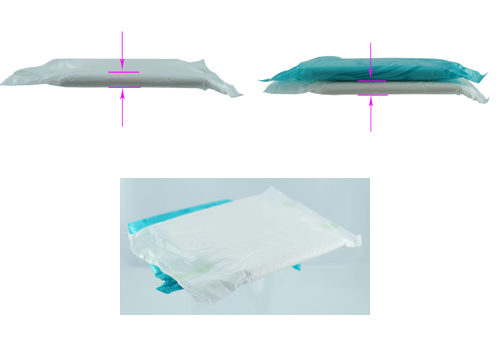
Category Archives: EVT
Particle Inspection on Semiconductor Wafers using EyeVision Software from EVT

EyeVision Machine Vision software has developed a program for wafer particle inspection, especially for the semiconductor industry.
Particles are probably the most common defects in wafer production. During transport, during processing, or even in the plant itself, particles such as dust or material abrasion can settle on the wafer. This can develop into an undesirable covering and alter the processing in this area.
The particles can prevent the etching or the precipitation of layers. This can lead to malfunctions such as short-circuits or missing electrical joints between conductors. The particle inspector of EVT software analyzes the surface of the wafer for dust and other particles, using a laser line.
EyeVision software recognizes even the slightest discrepancy and can send an evaluation of the wafer as Good or Bad. EyeVision software is very easy-to-handle and the particle inspection module can be adjusted easily in the graphical user interface.
Using EyeVision to Recognize Flux on Solar Cells
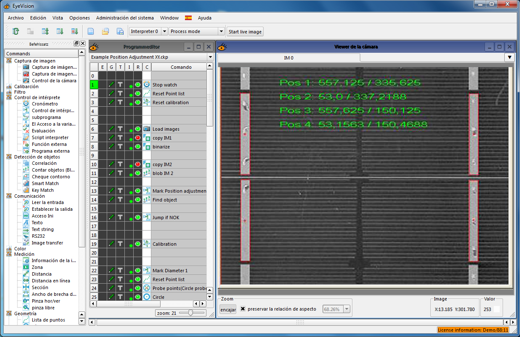
A reliable, accurate application of connecting materials such as flux, soldering paste or conductive adhesive is crucial to solar cell production.
EVT has developed a program which checks the application of flux. First, the software checks the presence of flux on the conduction bands, to verify if the flux has been applied. Additionally, EyeVision software program controls the admission of flux directly before soldering, which is especially important with mixed printed board assemblies.
The EyeVision inspection system optimizes the connection of solar cells and the construction of solar strings.
EyeVision software is easy to use. The programming is done in the graphical user interface with the drag-and-drop function. This means that for creating an inspection program no special programming skills are required. The commands are ready-made and the user has only to drag an icon from the Toolbox into the Program editor.
ChipControl – The One Command Set for the Visual Inspection of Electronic Components
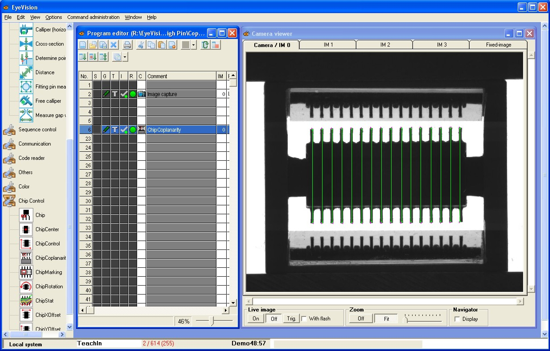
To meet the demands of automated visual inspections in the electronics assembly process, EVT has developed the “ChipControl“ command set for its EyeVision software.
There are various applications for the command set for quality inspection in the electronic and automotive industries: detection of bent contacts or leads; the presence of the chip housing; inspection of the coplanarity; recognition of the pin-one marker; orientation and position adjustment; the pin gap, etc.
In combination with the ChipEye 5-Side, electronic components can be captured from five sides and evaluated by EyeVision software at the same time. Good and bad parts can be separated quite easily. The 5-Side scanner is specialized for inspection of microscopically small components and covers a broad scope of applications.
ChipControl fits perfectly into the drag-and-drop programming of EyeVision software. The preprogrammed commands are displayed as icons and can be dropped into the inspection program without any programming skills. Additionally, EyeVision software is modularly expandable, which means that all the commands can be added in a later stage, without purchasing a new license.
3D Robot Guidance for Decorating Gingerbread
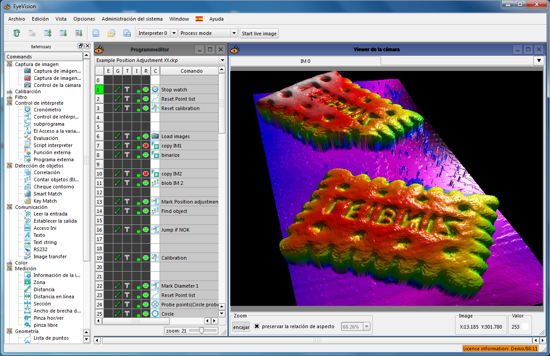
The EVT (EyeVision Technology) EyeScan AT 3D uses a three-dimensional sensor, whose data evaluation is carried out with the EyeVision image processing software. Using the 3D commands of the drag-and-drop programmable software, robot guidance becomes an easy-to-solve application.
For robot guidance, the 3D-positioning of the measuring object and its geometrical characteristics are detected. Additionally, the position discrepancy is calculated and the corrected data is forwarded to the robot system.
At the same time, the EyeScan AT 3D can inspect the surface of the objects, such as the surface texture of gingerbread cookies. During the baking process the gingerbread becomes slightly uneven and therefore has to be measured again separately one by one. The robot needs the orientation and height information for the subsequent sugar icing decoration of the pastry. For this application, the robot should position itself with the camera system above the gingerbread and then could measure and decorate the cookie.
Further application examples for the EyeScan AT 3D and EyeVision software are the adhesive bead and weld seam inspection, solar cell control, as well as tire and rubber inspection.
OCR can also be combined with 3D-surface inspection of embossed and debossed surfaces. The z-values of the 3D-inspection is recognized by the OCR-tool as lettering.
“Intelligent” sensors such as the EyeScan AT 3D are becoming increasingly relevant in industrial applications. By equipping an industrial robot with the proper sensors, the robot can carry out the task largely by itself.
ThermoCam LC – Thermal Imaging Sensor by EVT
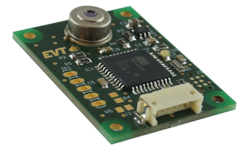 The ThermoCam LC was developed by EVT (EyeVision Technology) to provide low cost infrared solutions for the machine vision industry, and uses the thermographic command set of EyeVision software.
The ThermoCam LC was developed by EVT (EyeVision Technology) to provide low cost infrared solutions for the machine vision industry, and uses the thermographic command set of EyeVision software.
The TCLC allows an image capture of up to 100 images per second and is delivered already calibrated. The noise (NETD) is only 0.2K, which guarantees thermal images with high resolution. This means that the TCLC camera can work in conditions where a less sensitive camera might miss defects such as scratches and other flaws. Also, a reduced noise means that it is easier to focus the camera and to identify objects in the IR-image.
The ThermoCam works in a temperature range of -50°C to +300°C, with a field of view of 32×8 pixels, and optional opening angle of 40°, 60° or 120°.
The TCLC is suitable for applications such as detecting hot parts on a circuit board; delivering distant temperature measurements in critical processes; and measuring the temperature gradation on surfaces.
For example, the camera made it possible to distinguish different materials such as synthetic leather from real leather; to detect structural interruptions in fiber composites; and to measure the layer thickness of lacquer.
BrainLight QC – Back Light
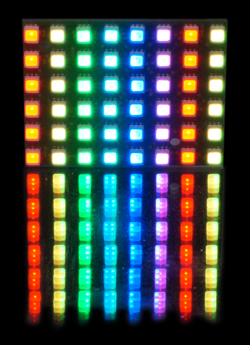 EVT (EyeVision Technology) introduces the newest back light of the BrainLight smart illumination series. The BrainLight QC for industrial use can be adjusted to almost any machine vision application.
EVT (EyeVision Technology) introduces the newest back light of the BrainLight smart illumination series. The BrainLight QC for industrial use can be adjusted to almost any machine vision application.
The LEDs of the intelligent back light can illuminate in red, green, blue and white. There is a diffusor plate in front of the LEDs, so that the light spreads evenly over the object. There are 48 full-color LEDs, which are arranged in a tight grid.
The user can choose any of the four available colors, and the LEDs can be switched on row by row. Light sequences can be programmed and played successively. The light can be dimmed, or work in complete brightness; even a flash mode is possible.
The BrainLight QC is 30 x 40 mm in size and has an input voltage of +24V. It is modularly expansible; LED rows can be added, depending on the application. Additionally, the QC back light has highly efficient switches, which guarantee minimal heat development.
Counting Eggs – not only on Easter
These days “Image Processing” is a topic in many industries and it is de rigueur in industrial applications. Hardly a production line can manage without industrial camera and evaluation software such as EyeVision. This also the case with Agribusiness.
One example is the counting of eggs on a conveyor belt. In modern chicken houses to handle this, camera-based systems are installed.
The difficulty here is, that the eggs on the conveyor belt are not in any order and sometimes are touching each other and sometimes not. In this current case the eggs on the image captured by an industrial camera, have to be separated not only from each other – egg between egg – but also from the background. Only then an accurate counting of objects can be guaranteed.
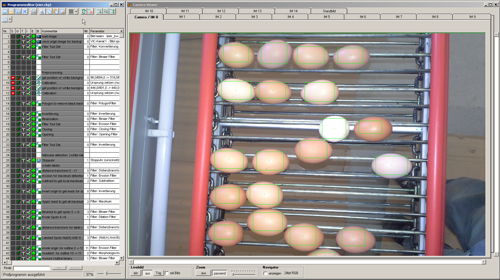
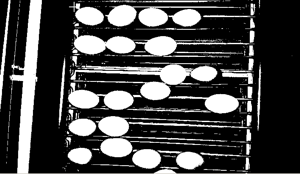
For this the EyeVision uses a series of filters, which allows it to separate and count the eggs under these conditions. Due to the intuitive drag-and-drop programming of the EyeVision software, these filters are easily applied and can be used in other cases, where other similar objects have to be counted.
But before that, there is the question of a suitable illumination or respectively an image, which is high in contrast. Additionally the shadow of the eggs should be as little as possible, as the separation of the eggs from the background and from each other can become blurred. A strong contour is essential to count objects.
For illumination e.g. a back light can be considered. This will have the result, that the eggs appear dark against a bright background. Alternatively the eggs can be illuminated from above with a strong incident light, which will show the eggs bright on a dark background. In both cases a daylight shielding is recommended.
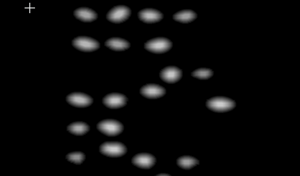
In our case, the second option was chosen – white eggs on black background – where the eggs are also separated clearly from the background. Several different filter commands are needed to separate and count the eggs, which are similar to each other in shape and color. The result are properly separated eggs, as shown in the Camera Viewer of the EyeVision software.
BrainLight R for a smart illumination

The BrainLight R is a smart ring light developed by EVT. This LED illumination is easily configurable and has a RS232 connection for industrial use. With this light any combination of illumination patterns can be created. Additionally, the light not only regulates the illumination patterns, but also controls that the camera captures only one image per illumination scene.
Programmed patterns, called Frames, can be saved and can be automatically reloaded after each restart. The ring light is equipped with a RS232 or TTL UART interface and power supply of +5V or 12-24V.
There are also predefined light patterns available and the possibility to regulate the brightness of the LEDs. The ring light is divided into 8 segments, each with 3 LEDs. Each segment can be controlled individually and dimmed in its intensity.
The control for the camera is done via strobe, and a PlugIn for EyeVision software makes the illumination completely graphically programmable.
V3 Ring light by EVT
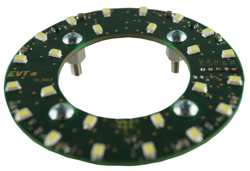 The V3 ring light by EVT is a configurable LED illumination for industrial usage with an RS232 connection. The V3 can display any kind of lighting pattern and can be controlled via a trigger input or optionally via RS232 interface.
The V3 ring light by EVT is a configurable LED illumination for industrial usage with an RS232 connection. The V3 can display any kind of lighting pattern and can be controlled via a trigger input or optionally via RS232 interface.
Programmed patterns can be saved and automatically reloaded after each restart.
The ring light is equipped with a RS232 or TTL UART interface and power supply of +5V or 12-24V. Additionally the ring light is separated into 8 segments, each with 3 LEDs. Each of these segments can be controlled individually and dimmed in intensity.
